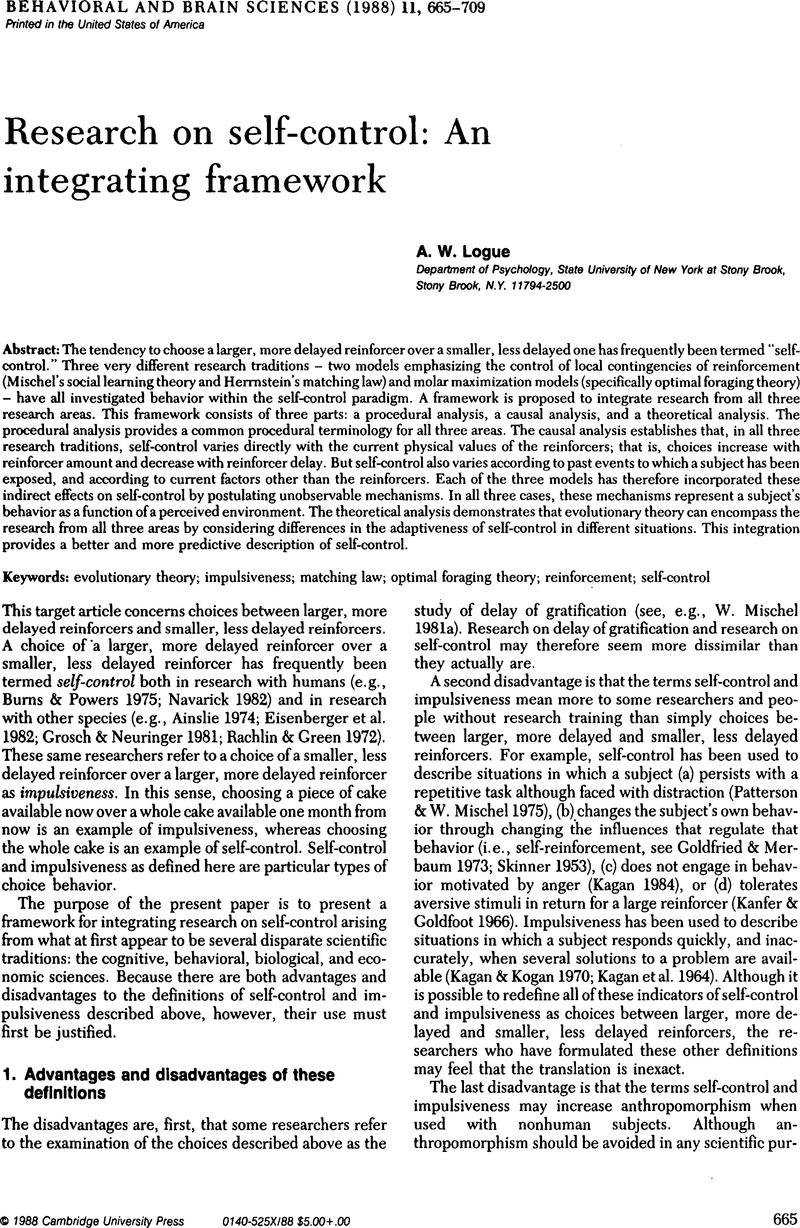Crossref Citations
This article has been cited by the following publications. This list is generated based on data provided by Crossref.
Logue, A.W.
and
King, George R.
1991.
Self-control and impulsiveness in adult humans when food is the reinforcer.
Appetite,
Vol. 17,
Issue. 2,
p.
105.
Green, Leonard
and
Myerson, Joel
1995.
Choice between long- and short-term interests: Beyond self-control.
Behavioral and Brain Sciences,
Vol. 18,
Issue. 1,
p.
127.
Hughes, Jordan
and
Churchland, Patricia S.
1995.
My behavior made me do it: The uncaused cause of teleological behaviorism.
Behavioral and Brain Sciences,
Vol. 18,
Issue. 1,
p.
130.
Baumeister, Roy F.
1995.
Transcendence, guilt, and self-control.
Behavioral and Brain Sciences,
Vol. 18,
Issue. 1,
p.
122.
Logue, A. W.
1995.
Form, function, and self-control.
Behavioral and Brain Sciences,
Vol. 18,
Issue. 1,
p.
136.
Killeen, Peter R.
1995.
The future of an illusion: Self and its control.
Behavioral and Brain Sciences,
Vol. 18,
Issue. 1,
p.
133.
Baum, William M.
1995.
Patterns yes, agency no.
Behavioral and Brain Sciences,
Vol. 18,
Issue. 1,
p.
122.
Overskeid, Geir
1995.
Thinking is a difficult habit to break.
Behavioral and Brain Sciences,
Vol. 18,
Issue. 1,
p.
138.
Hineline, Philip N.
1995.
The extended psychological present.
Behavioral and Brain Sciences,
Vol. 18,
Issue. 1,
p.
128.
Lemm, Kristi
Shoda, Yuichi
and
Mischel, Walter
1995.
Can teleological behaviorism account for the effects of instructions on self-control without invoking cognition?.
Behavioral and Brain Sciences,
Vol. 18,
Issue. 1,
p.
135.
Frank, Robert H.
1995.
Internal commitment and efficient habit formation.
Behavioral and Brain Sciences,
Vol. 18,
Issue. 1,
p.
127.
Wetherick, N. E.
1995.
Commitment: Beyond Rachlin's control?.
Behavioral and Brain Sciences,
Vol. 18,
Issue. 1,
p.
146.
Zentall, Thomas R.
1995.
The cost of an interrupted response pattern.
Behavioral and Brain Sciences,
Vol. 18,
Issue. 1,
p.
147.
Waller, Bruce N.
1995.
Pattern proliferation in teleological behaviorism.
Behavioral and Brain Sciences,
Vol. 18,
Issue. 1,
p.
145.
Rachlin, Howard
1995.
Self-control observed.
Behavioral and Brain Sciences,
Vol. 18,
Issue. 1,
p.
148.
Mele, Alfred
1995.
Conceptualizing self-control.
Behavioral and Brain Sciences,
Vol. 18,
Issue. 1,
p.
136.
Lacey, Hugh
1995.
Teleological behaviorism and the intentional scheme.
Behavioral and Brain Sciences,
Vol. 18,
Issue. 1,
p.
134.
Plaud, Joseph J.
1995.
The behavior of self-control.
Behavioral and Brain Sciences,
Vol. 18,
Issue. 1,
p.
139.
Branch, Marc N.
1995.
When is a pattern a pattern?.
Behavioral and Brain Sciences,
Vol. 18,
Issue. 1,
p.
123.
Shimoff, Eliot
1995.
Distinguishing between acts and patterns.
Behavioral and Brain Sciences,
Vol. 18,
Issue. 1,
p.
142.



